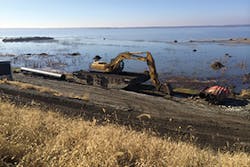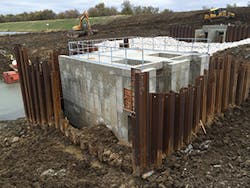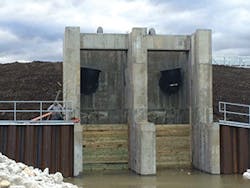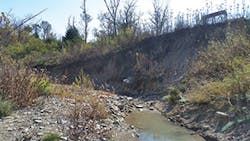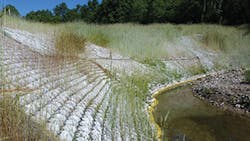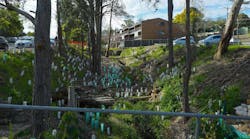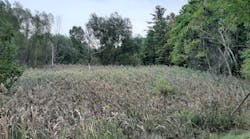If It Quacks Like a Duck, It Could Someday Be a Wetland
On a sultry afternoon in mid-July, two bodies of water, entwined by nature but separated by man, became reacquainted for the first time in nearly 100 years. The estrangement had been quite stressful for both, but expedience had dictated that third-party interests—those of agriculture, commerce, and development—would take priority over the harmonious relationship the two had enjoyed over countless prior millennia. With a bevy of anxious scientists officiating, the wall of separation thrown up by farmers, settlers, towns, and businesses was breached. An intricate mechanism of steel, concrete and earthen works, nets, baskets, and piping reunited the pair. According to scientists, the Illinois River and its adjacent floodplain known as the Emiquon Preserve would soon be restored to an age-old balance.
While coastal wetlands have received increasing attention under the threat of superstorms, sea level rise, and coastal erosion, the vast majority of United States’ wetland acreage can be considered inland rather than tidal. These inland marshes, bogs, and swamps along creeks, lakes, and low ground are more readily influenced by seasonal fluctuations in upland precipitation rather than hurricanes and tides. According to the US Department of Agriculture (USDA), 94% of wetlands of the continental US share this characteristic. Abutting streams and rivers, these wetlands often provide a fertile storehouse of nutrients and energy fed by eons of detritus deposited from upland biological communities.
A wetland’s unique biological productivity contrasts sharply with the biological activity in the main channels of rivers. Doug Blodgett, director of river conservation for the Nature Conservancy’s Illinois office, says that taken alone, the main channel of a river like the Illinois “is not very productive naturally, but the backwater areas are productive.” Wetlands act as the nurseries for fish and homes for birds, amphibians, and other wildlife, while performing the ecological service of “storing floodwaters, filtering pollutants, and serving as a carbon sink.”
According to Blodgett, farmers in the early 20th century recognized the productive potential of the fertile floodplain of the Illinois River, and soon afterward levees were thrown up, separating the river from the wetlands along its banks. Water trapped behind the levees was pumped over the berms and into the Illinois River, drying out the wetland and ushering in an era of intensive row-crop agriculture on the protected lowland, reducing biological diversity to the bare minimum required to get crops to market. He says similar activities have taken place on wetlands all across the US. According to USDA data, by 1980 more than 50% of the original 220 million acres of wetlands of the continental US had been drained or filled in for development and agriculture or other uses.
The practice of draining swamps and low-lying areas is probably as old as civilization. Some historians believe draining the floodplains of the Nile basin in ancient Egypt, and the Tigris and Euphrates rivers of Mesopotamia thousands of years ago, were the key events that started the trend toward accomplishments such as alphabets and cities, and represented the firsts steps toward modern society.Like the valleys of the Nile and Euphrates, scientists say, the Emiquon floodplain along the Illinois River had a prehistory as a fertile and highly-productive wetland. Artifacts such as Indian mounds and other signs of prosperity from ancient times provide silent testimony of an area so rich in biological diversity and productivity that entire cultures could not just survive, but thrive off the land and water as far back as 2,100 years ago.
The myths and rituals of the earliest peoples of the Emiquon remain a mystery; however, we know that the ancient Egyptians venerated one particular avian inhabitant of the Nile Valley wetlands. They held the sacred ibis in the highest esteem as the avatar responsible for writing, mathematics, measurement, time, the moon, and the wonders of magic. Believed extinct in Egypt due to habitat loss, urbanization, and a complexity of other causes, the bird is not uncommon in sub-Saharan Africa. Wading through marshes and dining on frogs, insects, and other small creatures, it has a call not quite reminiscent of a duck’s but distinctive nonetheless.
As part of its mission to reverse the trend of disappearing habitat, the Nature Conservancy began laying the groundwork for one of the nation’s largest wetland restoration projects by buying up lowland along the Illinois River. In cooperation with US Fish and Wildlife Service and other partners, the Nature Conservancy amassed a plot of 6,700 acres of lowland farms in the fertile river valley at a place called Emiquon. The next step was simple—they turned off the pumps.
It was an “instant win” for the environment, says Blodgett. Eliminating the fossil-fuel-powered pumps “reduced the greenhouse gas footprint of the landscape,” contributing to the ecological recovery of the planet as a whole. Meanwhile, he says, “transforming the land use from energy-production crops to wildlife habitat” would tend to absorb rather than emit greenhouse gasses by capturing carbon and nutrients in the emergent vegetative biomass.
Fast Recovery
Blodgett marvels at how quickly lands, that had performed marginally as farms, returned to a productive natural state as they became saturated with moisture percolating in from upland in the watershed. With the pumps powered down, the next step in restoring the wetland would be to reconnect the river with its floodplain. The simplest way to do that, he says, would be to take the levee out completely and let the water flow where gravity would have it. However, Blodgett felt such an unsophisticated approach would result in chaos.
Because of widespread hydrological alterations in the Illinois River watershed, he says, “the river and its floodplains no longer follow natural seasonal fluctuation patterns of low and high water essential to wetland ecological function.” Under current conditions, upland areas of the watershed have been so altered “that they cannot store floodwaters, so floods are bigger” than they used to be and dry spells are drier, he says. Ping ponging between extremes does not bode well for healthy wetlands.
The Nature Conservancy sought a way to manage flows that would moderate the influences of hydrological alteration and mirror the historic natural seasonal fluctuations in water levels needed to support aquatic plants and animals in the wetland, the river, and the upland environment.
The Nature Conservancy’s plan called for the installation of a specially designed control structure connecting the floodplain and river—engineered to judiciously manage flows into and out of the wetland to approximate the natural seasonality of flows.
“Hydrology is the driver of wetland ecosystems. The control structure is to manage flows and simulate the spring flood pulse, but also to have the ability to stabilize flows throughout the rest of the year to more closely resemble seasonal variability that existed 100 years ago,” says Blodgett.
Rather than dismantle the levees, the plan called for installing a pair of concrete box culverts, 120 feet long by 8 feet wide and 7 feet floor to ceiling, at a strategic point to pass flows between the river and the wetland. These control structures were equipped with massive gates to seasonally adjust the amount of water flowing between wetland and river.
History Under Water
Keith Plavec, lead engineer on the project, recalls his first visit for an initial assessment of the work site. “We went out by airboat and I see this old building sitting out there. It didn’t make a lot of sense. There were pipes and the old pumps there sticking out of the water.” From the depth of the water and how quickly it had filled in the area behind the levee, he says, “you could see how much water had been kept at bay by the pumps every day.”
The old building was one of the pump houses that, for generations, had been dedicated to keeping the Emiquon dry. With the pumps retired, the time had come to demolish and haul off the vestiges of the defunct pump station, installing in its place the two specially designed gated box culverts to regulate flows.
Good fortune speeded the work, Plavec says. Although the Illinois River had experienced “record-setting floods” earlier in the year, by the start of the work season the region was experiencing record-setting dry conditions. As a result, “We never had to worry about water coming into the construction site.” Nonetheless, Laverdiere Construction brought in its John Deere floating excavator to construct earthen cofferdams on both sides of the work site. Crews also installed silt fences to keep silt out of the wetland and then began dismantling the pump house and pumps.
“I’d hate to not have the John Deere on a wetland project,” says Jon Lundgren, construction manager for Laverdiere Construction.
Describing the workflow, Lundgren says, “When we got the inside pumped down, we had to dry it out to get the piling in and build temporary levees.” Then the hard part began. Removing the old pump station “was more of a challenge than anybody thought.”
installed to allow water to flow between river and wetland.
After the cranes and excavators removed the mechanical components, Plavec says, digging deeper into the pump house site revealed a history of almost makeshift, but still effective, water exclusion techniques. “There were multiple pump stations. This was originally called Norris Farms, and the farmers had installed tiles that went to the drainage ditches and then ultimately went all the way back to the pump station. The old pump station had diesel pumps and big flywheels, and there was this big concrete block that was just deep in there. There were even caissons—steel filled with concrete placed on the four corners.
“When we started the project, all that was no longer in use,” continues Plavec. There were, however, “two vertical pumps set into the water a little bit that had discharge pipes next to them, which the farmers ran continually so they could keep the water level down. These were very easy to remove. We ran into old wood sheet piling that looked like trees sharpened to a point and just driven into the ground way back when. All of that was right where the new box culverts were to be installed. It was a big part that we had to get out of the way before we could put our work in.”
Project construction on the two wetlands began in November, with the danger of winter freeze just weeks, or perhaps days, away. However, as Smith explains, the November window is also prime time for working in the Devil’s Lake wetland environment. “Freezing helps our access, of course, but it also hinders our embankment construction process—we don’t want to put any frozen material in that embankment.” On the other hand, he says, fall is “typically our driest time of the year, so it was chosen as the season that we wanted to construct this particular project.”
Brad Karel, construction manager for Ducks Unlimited, says work began with plowing in a silt fence on the downstream side of the embankment. “We had to have specialized equipment that would operate in soft conditions. We had scrapers hooked to Caterpillar Challengers operating on tracks. Everything was low-ground-pressure equipment because the soils are very wet around the periphery of the drained wetlands.” He adds, “We had to obtain our embankment construction material away from the site, so we had to be able to transport that material over soft conditions also.”
Karel says the contractor also brought in a Case International Harvester IH four-wheel-drive tractor with rubber tracks, “which makes it a low-ground-pressure machine that would have a ground pressure equivalent to less than the human foot. You’ve got to be able to float those machines loaded with clay over top of the wet soils.”
To round out the inventory of heavy machinery used during construction, contractors employed a Bell scraper tractor, “which is a larger floatation tire tractor pulling box scrapers.”
On the spillway of the second restored wetland on the property, says Smith, installers used LANDLOK 1060 turf reinforcement mats to pass the somewhat smaller peak flows expected in a similar manner to the larger wetland, while reinforcing the turf “without adding more height to the embankment.”
He notes, “We very well may have been able to just seed it properly, and had we had good grass established, that would very likely have been the solution. But in this case, we were worried a little bit about that period of time prior to full vegetation, so that turf reinforcement mat helps protect it while it’s getting fully vegetated.”
Karel says turf reinforcement materials such as the LANDLOK 1060 also helped to ensure a maintenance-free overflow. “That’s the big thing here—we don’t want to be going back to maintain anything, whether we’re using native plants to reinforce those soils or the concrete Flexamat providing armor for the water to flow over and not erode our spillways and embankment.”
Of the Flexamat installation, Smith says, “The speed at which that product could be put down was a consideration for why we chose it.”
“We were able to have all that product down in three hours,” adds Karel. “And the snowstorm came one day after we got it completed, so it turned out to be a timely completion.”
A year later, Hieb says the restored wetlands “have been holding roughly a foot of water this past season when we did our monitoring of the site. The vegetation is establishing nicely; that will take multiple years to really fill in, but that slow process is something that we will monitor. And there were no signs of erosion.”
In the Spillway
Flexamat is a permanent erosion control mat used for stabilizing slopes, channels, low water crossings, inlet and outlet protection, and shorelines. It consists of concrete blocks, 6.5 inches square with a 2.25-inch profile, locked together and embedded into a high-strength geogrid. The 1.5-inch spacing between the blocks provides flexibility and allows for vegetation growth. The mat is packaged in rolls, which makes transportation and installation of Flexamat efficient.
A wide range of native plant species thrives within the armored matting. Flexamat is a drivable surface and safe for people and wildlife to walk across. The system can be maintained with commercial mowing equipment. Flexamat offers a highperformance, is environmentally friendly, and is an aesthetic solution for a wide variety of erosion problems.
The mat’s unvegetated hydraulic capabilities are 24+ pounds per square foot and 19+ feet per second, per ASTM D6460, 30% channel testing over sandy loam (USDA).
